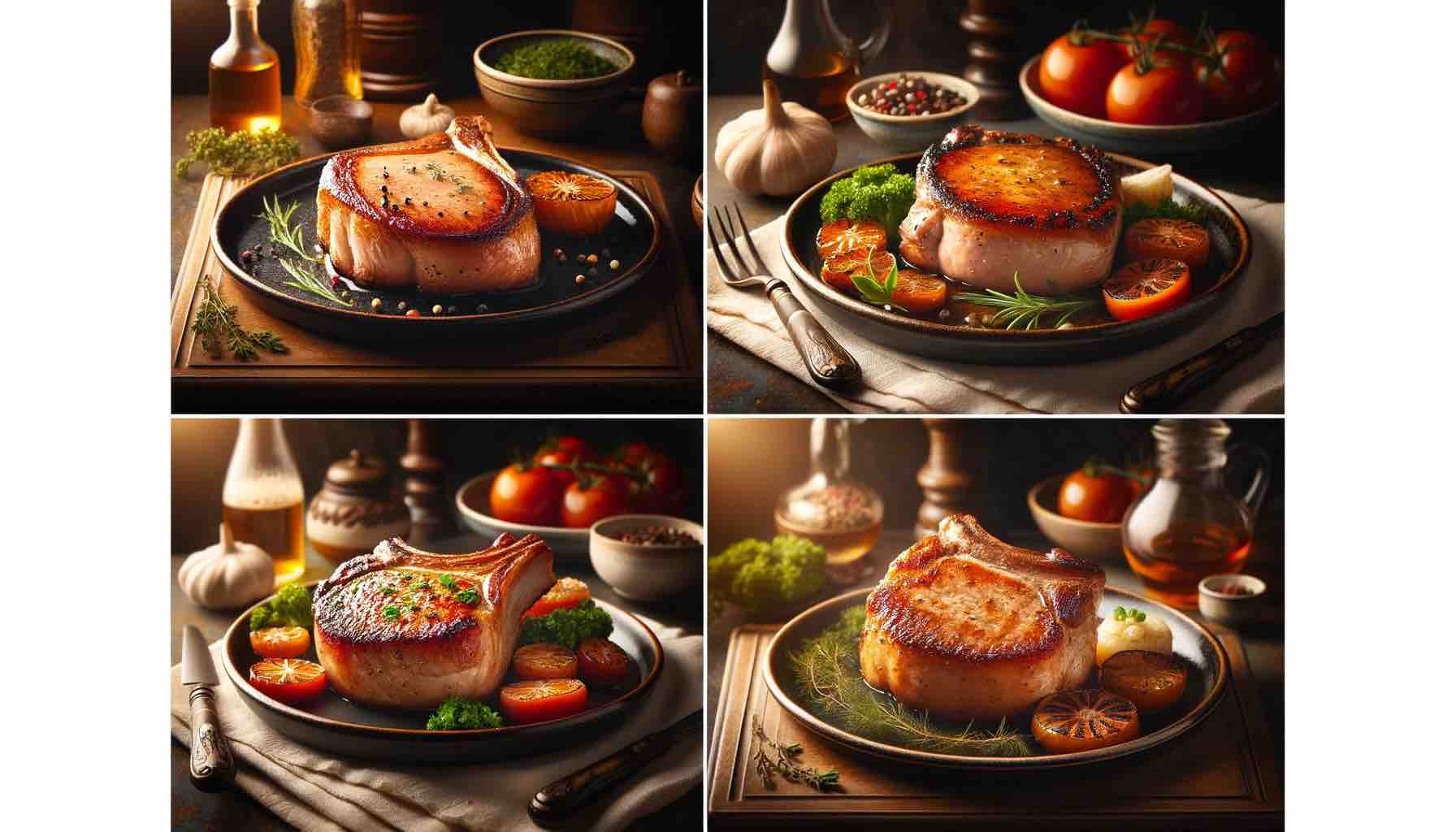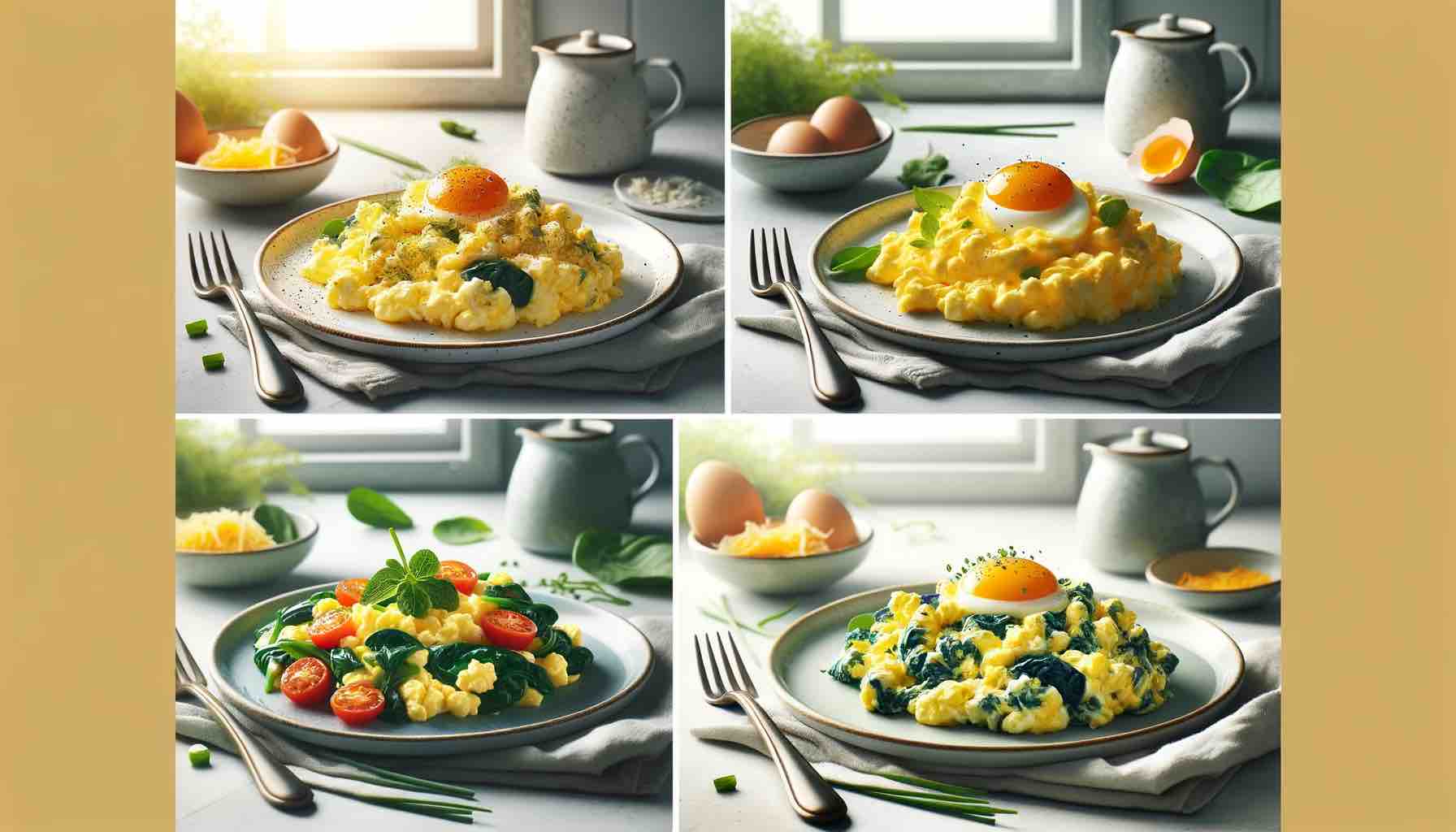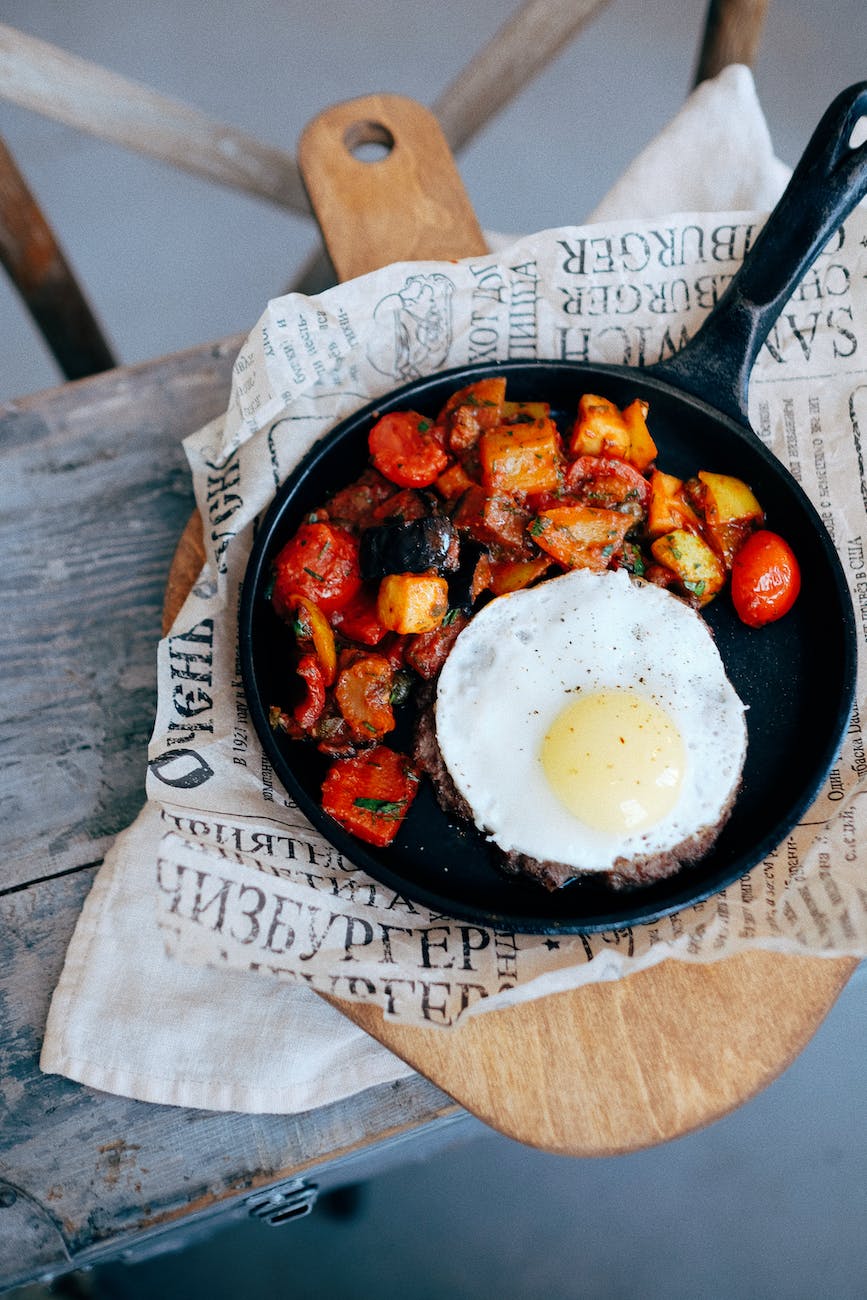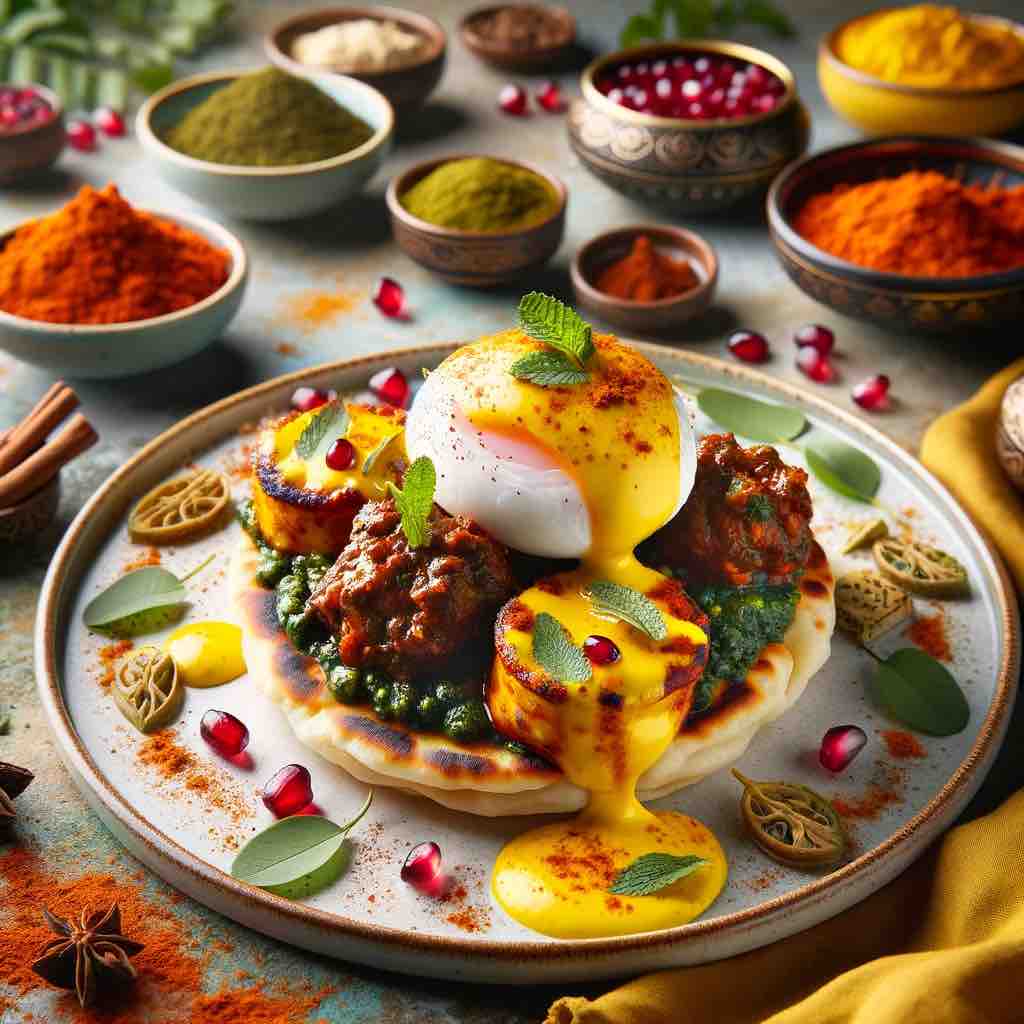
Welcome to a Flavorful Fusion!
Imagine a dish that combines the elegance of Western brunches with the vibrant zest of Indian cuisine. That’s what we’re diving into today! Welcome to our exploration of Eggs Benedict, a classic that has graced breakfast tables around the world, now ready to be infused with a delightful Indian twist.
Why Eggs Benedict?
Eggs Benedict, traditionally a symphony of English muffins, poached eggs, Canadian bacon, and Hollandaise sauce, has always been a symbol of indulgent mornings and leisurely brunches. But what if we add a dash of desi magic to it?
What’s in Store for You
In this post, we’re not just revisiting the classic recipe; we’re reinventing it! We’ll explore the top five Eggs Benedict recipes from renowned culinary sites and then, hold onto your taste buds, we’re going to Indianize them! Think tandoori chicken replacing Canadian bacon, naan instead of English muffins, and a Hollandaise sauce with a spicy twist. And then there is the contest, for those who enjoy cooking and sharing, read till the end!
Join the Culinary Adventure
So, whether you’re a seasoned chef or a curious foodie, this post is your ticket to creating a brunch that’s truly unforgettable. Let’s embark on this delicious journey together, blending the best of both worlds, one poached egg at a time!
Exploring the Classics: A Deep Dive into the Top 5 Eggs Benedict Recipes
1. The Quintessential Classic: Allrecipes’ Traditional Eggs Benedict
- The Original Blueprint: Allrecipes’ traditional Eggs Benedict recipe is a homage to the classic version of this beloved brunch dish. It’s a comprehensive guide for those who value authenticity and want to recreate the timeless taste of Eggs Benedict.
- What You’ll Learn: This recipe meticulously details each step, from toasting the English muffins to perfection, poaching eggs to just the right degree of runniness, layering the Canadian bacon, and finally, draping everything in a velvety Hollandaise sauce.
- Why It’s a Must-Try: Perfect for culinary enthusiasts who appreciate the elegance of traditional cooking and are looking to master the foundational recipe of Eggs Benedict.
2. The Art of Precision: Simply Recipes’ Eggs Benedict
- Culinary Choreography: The Simply Recipes version of Eggs Benedict focuses on the delicate balance and timing required to bring this dish to life. It’s a testament to the art of cooking, where every component must come together in perfect harmony.
- Key Highlights: The recipe guides you through achieving crispy, yet not overdone bacon, butter-laden English muffins with just the right amount of crunch, eggs poached to a delicate tenderness, and a Hollandaise sauce that’s creamy and rich without being overpowering.
- Ideal For: This recipe is a fantastic choice for those who love the intricacies of cooking and enjoy the challenge of juggling multiple elements to create a harmonious dish.
3. Mastering the Poached Egg: Allrecipes’ Detailed Guide
- The Centerpiece of the Dish: The poached egg is arguably the star of Eggs Benedict, and the Allrecipes guide offers an in-depth tutorial on mastering this technique. It’s a deep dive into achieving that elusive perfect consistency.
- What’s Inside: The guide covers everything from the right water temperature to the gentle swirling technique that ensures your eggs are beautifully encased in a delicate white cocoon, with yolks that are runny and rich.
- For Whom: This guide is an invaluable resource for anyone who has struggled with poaching eggs or is keen to perfect this essential skill in their culinary repertoire.
4. The Homemade Touch: Tastes Better From Scratch’s Eggs Benedict
- Bringing Brunch Home: Tastes Better From Scratch offers a recipe that brings the sophistication of a brunch restaurant into the comfort of your home. It’s about creating something extraordinary from everyday ingredients.
- Recipe Highlights: The focus is on a homemade Hollandaise sauce that’s surprisingly simple yet incredibly flavorful, coupled with the classic components of Eggs Benedict, all prepared with a personal touch.
- Why It’s Special: Ideal for home cooks who want to impress family and guests with a dish that looks as stunning as it tastes, this recipe is a testament to the joy of homemade culinary creations.
5. The Restaurant-Style Experience: NatashasKitchen’s Elegant Eggs Benedict
- Elevating Breakfast to Fine Dining: NatashasKitchen’s Eggs Benedict recipe is all about recreating the finesse of a high-end brunch spot in your own kitchen. This recipe is a blend of visual appeal and exquisite taste.
- What to Expect: The recipe walks you through creating a visually stunning and palate-pleasing dish, with tips on presentation and flavor enhancement that elevate the ordinary Eggs Benedict to something truly extraordinary.
- Perfect For: Those who love to bring a touch of gourmet flair to their cooking, this recipe is a gateway to transforming a simple breakfast into a luxurious dining experience.
In this section, we’ve explored the top five Eggs Benedict recipes, each offering unique insights and techniques. These recipes provide a solid foundation for anyone looking to master this classic dish, setting the stage for creative adaptations and personal touches.
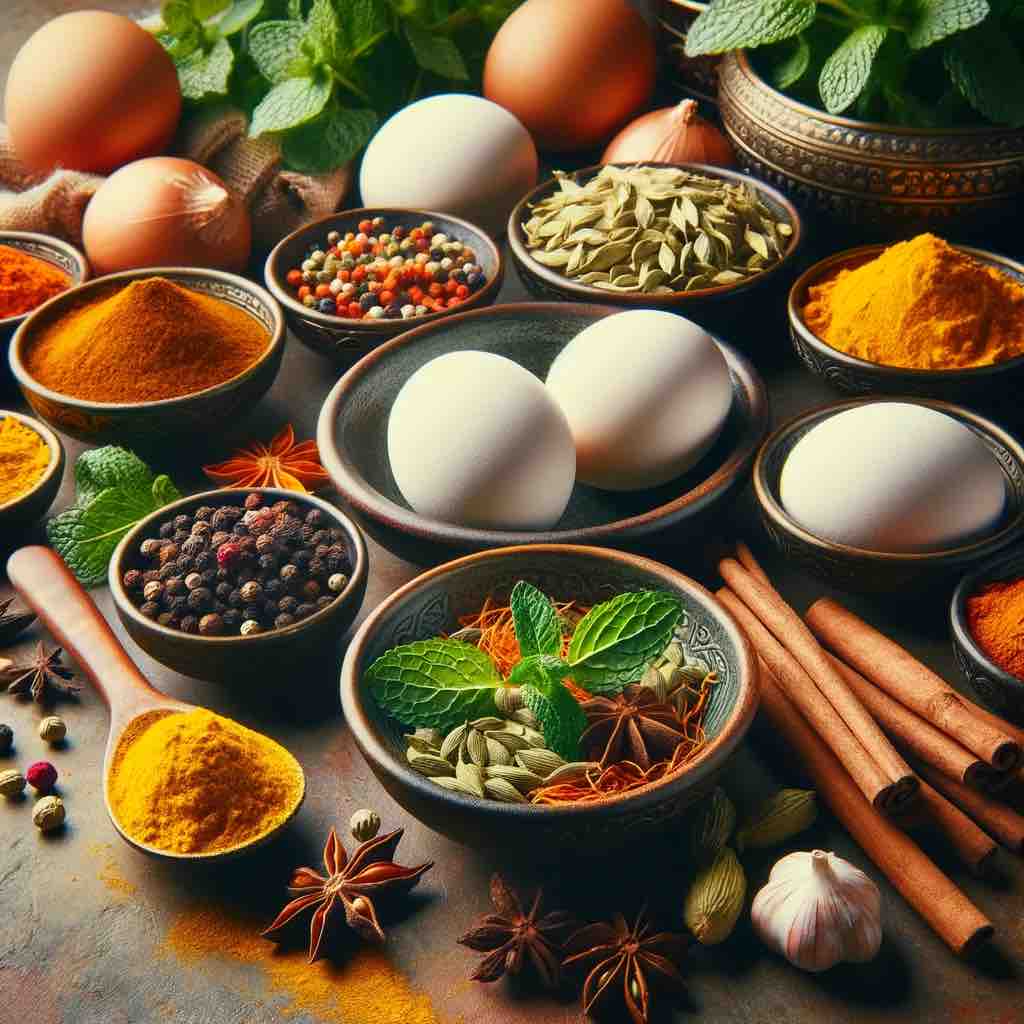
Eggs Benedict: A Diverse Indian Culinary Odyssey
Revolutionary Base Options:
- Dhokla or Idli: Start with a light, airy dhokla or a soft, steamed idli. These traditional snacks offer a unique, spongy texture, perfect for soaking up flavors.
- Ragi Dosa or Jowar Roti: For a healthier twist, consider a ragi (finger millet) dosa or a jowar (sorghum) roti. These grains are not only nutritious but also bring a nutty flavor to the base.
- Bhatura or Puri: For a richer option, try a fluffy bhatura or a crispy puri. These deep-fried breads add a delightful crunch and indulgence to the dish.
also read 10 Examples of Egg Dishes, with 2 Eggs
Protein Variants Beyond the Ordinary:
- Chettinad Chicken or Goan Prawn Balchão: Spice up the protein layer with a fiery Chettinad chicken or a tangy Goan prawn Balchão, both bursting with regional Indian flavors.
- Masala Vada or Paneer Tikka: For vegetarians, a crunchy masala vada or a smoky paneer tikka can replace the traditional meat, adding a delightful texture and rich taste.
- Amritsari Fish or Lamb Galouti Kebab: Experiment with Amritsari fish, known for its spicy batter, or a melt-in-the-mouth lamb Galouti kebab for a luxurious touch.
Eggs with an Indian Infusion:
- Masala Poached Egg: Infuse the poaching liquid with a bouquet of Indian spices like star anise, cinnamon, and bay leaves for a subtly spiced egg.
- Tandoori Egg: Marinate a soft-boiled egg in a tandoori masala and give it a quick char for a smoky, spiced exterior.
- Egg Bhurji: Replace the poached egg with a spicy, scrambled egg bhurji, rich with onions, tomatoes, and a mix of Indian spices for a heartier option.
Innovative Sauces:
- Mint-Coriander Hollandaise: Blend the classic Hollandaise with mint and coriander for a refreshing, herby twist.
- Coconut-Tamarind Hollandaise: Combine coconut milk and tamarind paste for a sweet and sour version, adding a South Indian flair.
- Tomato and Fenugreek Hollandaise: A tomato-based Hollandaise infused with dried fenugreek leaves can offer a tangy and aromatic alternative.
Also read Coconut Milk Nutrition Facts & Glycemic Index Impact
Garnishes with a Creative Edge:
- Fried Curry Leaves and Sliced Almonds: Add a crunch with fried curry leaves and a nutty flavor with sliced almonds.
- Pomegranate Seeds and Sev: Sprinkle pomegranate seeds for a burst of sweetness and sev (crispy chickpea flour noodles) for an extra crunch.
- Pickled Vegetables and Microgreens: Top with tangy pickled vegetables and fresh microgreens for a burst of freshness and a contrast in textures.
This reimagined Eggs Benedict is a journey through the vast and varied landscape of Indian cuisine. Each component offers a chance to explore different regional flavors and textures, encouraging culinary experimentation and creativity. It’s a dish that not only tantalizes the taste buds but also tells a story of India’s rich and diverse culinary heritage.
Join the Culinary Adventure: Share Your Creations with #MasalaMonk
We’ve embarked on a flavorful journey, reimagining the classic Eggs Benedict with a vibrant Indian twist. Now, it’s your turn to bring these ideas to life in your kitchen. We encourage you to experiment, mix and match, and create your own unique versions of this iconic dish. Whether you stick to the traditional roots or venture into uncharted culinary territories, we want to see your creativity shine!
Here’s How You Can Participate:
- Create and Experiment: Use the ideas shared as a starting point and add your personal touch. Whether it’s a new base, a twist on the protein, an innovative sauce, or an unexpected garnish, let your culinary instincts lead the way.
- Capture and Share: Once you’ve created your masterpiece, take a beautiful photo and share it on Instagram. Use the hashtag #MasalaMonk so we can find your creations easily. Don’t forget to tag us in your post!
- Engage with the Community: After sharing your creation on Instagram, come back to this post and leave a comment. Share your experience, the recipe, or any tips you have for fellow food enthusiasts. This is a great way to connect with others who share your passion for cooking and Indian cuisine.
Exciting Rewards Await!
- Get Featured: We’ll be keeping an eye out for the most interesting, innovative, and mouth-watering recipes. The best creations will be featured on our platform, showcasing your culinary talent to a wider audience.
- Win MasalaMonk Goodies: As a token of appreciation, selected entries will receive special goodies worth Rs. 2100, from MasalaMonk.com. It’s our way of celebrating your culinary skills and encouraging you to keep experimenting.
This is more than just a cooking challenge; it’s a celebration of flavors, creativity, and community. So, put on your chef’s hat, get those spices ready, and start cooking! We can’t wait to see what amazing dishes you come up with. Happy cooking, and may the best Eggs Benedict win!
Further Reading: Exploring the Nutritional World of Eggs
For those of you who are as fascinated by the versatility and nutritional benefits of eggs as we are, we’ve compiled a list of insightful articles. These reads will not only deepen your understanding of the nutritional aspects of eggs but also inspire you with delicious egg-based recipes. Dive into these resources for a comprehensive look at eggs from various culinary and health perspectives:
- Protein Powerhouse: Discover the impressive protein content in boiled eggs and explore their comprehensive nutritional profile, including calories, fats, vitamins, and minerals. Read more about the protein in two boiled eggs.
- Yolk Wonders: Uncover the rich nutrient content of egg yolks, including proteins, vitamins, minerals, and fatty acids. This article is a must-read for understanding the health benefits and culinary uses of egg yolks. Explore the nutritional protein profile of egg yolks.
- Egg Whites Unveiled: Learn about the low-calorie and high-protein profile of egg whites, their role in various diets, and their versatility in cooking. This piece is particularly useful for those interested in weight management and muscle building. Delve into the calories and nutrition in egg whites.
- Scrambled Egg Nutrition: Gain insights into the protein-rich nature of scrambled eggs, including their caloric and fat content, along with tips for healthier preparation. Read about the protein in 3 scrambled eggs.
- Creative Egg Dishes: Get inspired by ten delightful egg dishes prepared with just two eggs. This article offers a creative culinary perspective, expanding your options for incorporating eggs into your meals. Explore 10 examples of egg dishes with 2 eggs.
These articles collectively offer a well-rounded perspective on eggs, catering to fitness enthusiasts, health-conscious individuals, and culinary aficionados alike. Whether you’re exploring the protein-packed world of boiled eggs, delving into the nutrient-rich yolk, opting for the lean protein of egg whites, or enjoying the wholesome goodness of scrambled eggs, these posts provide valuable information to enhance your dietary choices and cooking repertoire.
FAQs for “Indian Fusion Eggs Benedict: A Culinary Adventure”
- What makes Indian Fusion Eggs Benedict different from the traditional version?
- Indian Fusion Eggs Benedict transforms the classic dish with bold Indian flavors. It incorporates elements like spiced kulcha or idli as the base, richly flavored proteins like lamb keema or paneer tikka, and innovative sauces such as mint-coriander hollandaise, offering a unique and vibrant culinary experience.
- Can I make a vegetarian version of Indian Fusion Eggs Benedict?
- Absolutely! A vegetarian version can include paneer bhurji or masala vada as the protein. You can also experiment with various vegetarian toppings like spiced tofu or vegetable kebabs to add your personal touch.
- What are some healthy alternatives for the base in Indian Fusion Eggs Benedict?
- For a healthier base, consider using ragi dosa, jowar roti, or a lightly toasted multigrain bread. These options provide a nutritious twist while maintaining the dish’s integrity and flavor.
- How can I infuse Indian flavors into the Hollandaise sauce?
- Infuse the Hollandaise sauce with Indian herbs and spices like mint, coriander, or a hint of garam masala. You can also experiment with coconut milk or tamarind for a unique South Indian twist.
- What are some creative egg options for this dish?
- Instead of the traditional poached egg, try a masala poached egg, a tandoori spiced soft-boiled egg, or even an egg bhurji for a heartier option. Each style adds a different texture and flavor to the dish.
- Can I prepare Indian Fusion Eggs Benedict for a large group?
- Yes, this dish can be scaled up for larger groups. Prepare components like the base and protein in advance, and assemble with freshly poached eggs and sauce when ready to serve.
- Are there any quick and easy versions of this recipe?
- For a quicker version, use pre-made components like store-bought naan or roti as the base, and simplify the toppings with readily available ingredients like pre-cooked meats or paneer.
- What are some garnishing ideas to enhance the dish?
- Garnish with crispy fried onions, fresh herbs like cilantro, and pomegranate seeds for a sweet crunch, or a sprinkle of chaat masala for an extra zing.
- How can I make this dish vegan-friendly?
- To make a vegan version, use a vegan bread base, tofu scramble or spiced chickpea mixture as the protein, and a cashew-based vegan hollandaise sauce. Replace the egg with a tomato or avocado slice for added freshness.
- Where can I share my version of Indian Fusion Eggs Benedict?
- Share your creation on Instagram using the hashtag #MasalaMonk. Don’t forget to come back and comment on our post with your experience and recipe. The most interesting recipes might get featured and win goodies from MasalaMonk.com!
Blog Tags for the Post
Indian cuisine, fusion recipes, Eggs Benedict, vegetarian options, healthy cooking, Indian spices, culinary creativity, home cooking, food experimentation, brunch ideas, gourmet dishes, international cuisine, cooking tips, recipe sharing, food photography, Masala Monk, culinary adventure, Indian flavors, innovative cooking, food blogging

